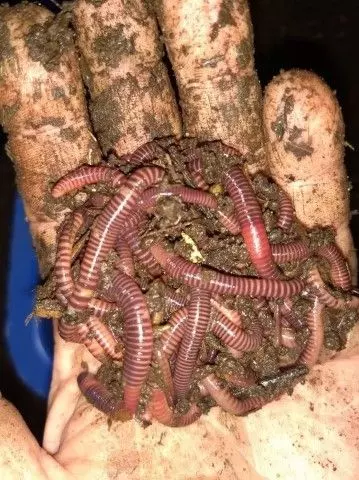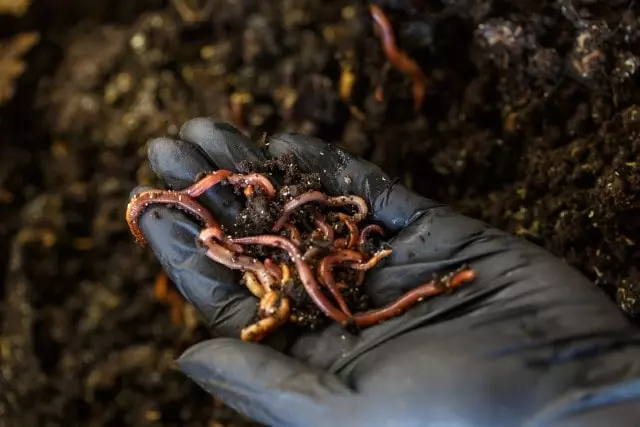Vermiculture or Worm Farming consists of the intensive cultivation of the Californian red worm (Eisenia fetida) in organic residues used as fertilizer for crops. These organic wastes thrown by the Worm, named Humus, represent the highest state of decomposition of organic matter. It is compost of excellent quality. In addition, the Californian red worm has 70% protein, which means that it is ideal for feeding animals such as pigs or fish. Learn all about red worms farm in this article.
The handling of Californian worms is straightforward and ideal to have on the farm since all organic waste, such as animal manure and leftover vegetables from crops, is its food. The differences between the California worms and the common earthworms are apparent. In the case of the California worms, they can multiply up to 512 times in the course of an active life. Meanwhile, a wild or common earthworm can multiply only 4 to 6 times during life.
The Californian red worm is an incomplete hermaphrodite: male and female at the same time. Therefore, 2 worms are necessary for reproduction. Then, as a result of two worms, an ootheca or capsule of each one will be produced, which will hatch after 17 to 21 days of placement, giving rise to 2 to 20 juvenile California worms.
Table of Contents
Red Worms Farm: Reproduction of Red Worm
The California worms live for approximately 16 years, during which they mate regularly every 7 days if the temperature and humidity of the environment are to your liking. The Californian worms reach sexual maturity at 3 months of age. As a result of the coupling of two worms, two eggs or capsules will be produced (one from each California worm). These capsules will open after 12 to 21 days of incubation, depending on the temperature of the medium where they are located. Each egg or capsule contains 2 to 21 small Californian worms. The number depends on the management that is being given to the Vermiculture (food, the acidity of the environment, humidity, temperature, etc.). Constant control of temperature, pH, and aeration are some of the most important factors for success.
The environmental conditions must be optimal, either for the production of humus or for sexual activity. A good temperature of the immediate environment oscillates around 66-68ºF (19-20 °C). Temperate climates, such as the coffee zone, are ideal for the cultivation of the red worm. Likewise, the handling that is given to the Vermiculture is very important as it is an ideal food, quality water, and in the necessary quantity.
Two red worms can produce each one, under normal conditions about 1,500 worms a year. Therefore, a couple will give rise to 3,000 worms. Every 14 days, the capsules break, giving rise to 20 newborn red worms that, at three months, will already be sexually mature and these, in turn, will multiply among themselves.
From the moment of their birth, the red worms are self-sufficient; They eat alone, and they only need to survive so that the substrate where they are found is moist and tender enough.
Scientifically, it is proven that there are no differences in performance with respect to the infrastructure chosen to grow worms or to obtain humus. No difference was found in the worm population in beds or boxes and pit environments.

Beds or Boxes for California Worms
Beds or Boxes for California Worms. They constitute the space in the space in which the Vermiculture process is carried out. You can use a mat, bamboo, or brick manufacture. These must be built 1 m wide and the length according to the availability of the land; in general, modules of 2 to 3 meters long are used. The most usual bed height is 16” (40 cm). The space between beds can be 20” x 20” (50×50 cm). Some vermiculture uses wooden boxes or plastic baskets.
Learn more about How to make a red worm farm.
Red Worms Farm – Floors
Inside the red worms farm, a cement floor, plastic cloth, mat, or some material that allows the crop to be isolated from the soil is recommended to avoid attack by possible pests (flatworms such as planarians, leeches, ants). The floor built with a slope between 2 and 5% prevents flooding of the bed when irrigation is used.
Red Worms Farm – Roofs
It is recommended to isolate the red worms farm from direct rain and provide shade and better conditions for the California worms to work. In addition, it facilitates the handling of materials. The height can be about 98” x 120” (2.50 to 3 m).
Red Worms Farm Enclosure
It is convenient to close the red worms farm with fabric for shade or mesh to avoid the entry of birds and other predators.
Sowing System
Vermiculture begins by depositing the broodstock on the beds, making sure that this initial layer is approximately 4” x 6” (10 to 15 cm). If necessary, you can complete this height by depositing the substrate at the bottom of the bed and then placing it on top of the brood food. This ensures that the red worm has the means to take refuge if food conditions are not adequate.
Red Worms Farm: Worm Farming Management
A. Food: Use thin layers of food (maximum 4 cm) to avoid heating it when it is used very fresh, to facilitate the aeration of the crop, ensure the transformation of the material, and keep the California worms feeding on the upper part. A piece of advice: something to stimulate reproduction, a simple change of diet with other residues turns the process into a successful one. Such as manure from different animal species (cattle, pigs, horses, rabbits) or residues from other crops. In our experience, pig manure was the best substrate for the production of California worms (compared to horse manure) since it presented the most favorable conditions, obtaining a larger size.
B. Frequency and quantity: It can be fed once or twice per week, depending on the density of the worms and the type of food. The amount of food is directly related to the number of red worms. Calculate a consumption equivalent to half the weight of worms per day. It is advisable to keep records of the diet and the general functioning of the Vermiculture. Remember to move the soil to aerate every 2 or 3 days after placing food and after watering.
C. Irrigation: Prepare the food before taking it to the California worm beds. Soak as necessary until it is totally moistened. It does not drain. This roughly corresponds to a range of 50 to 85% humidity. Soak the beds to retain this moisture. Prepare irrigation with clean water and, depending on the environmental conditions and the thickness of the layer of substrate with worms.
We hope you find this guide about the red worms farm useful. Learn more about How to make a worm composting bin.

